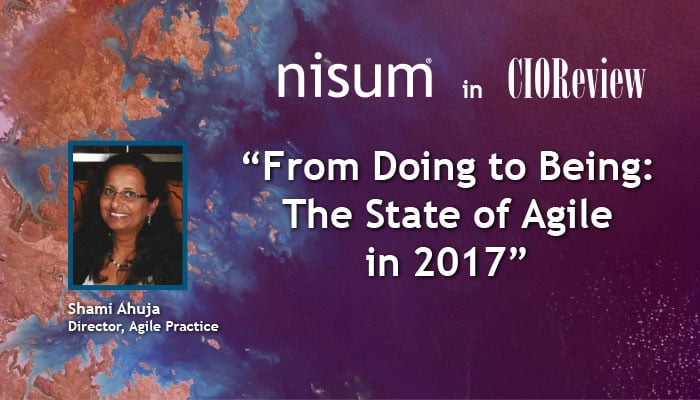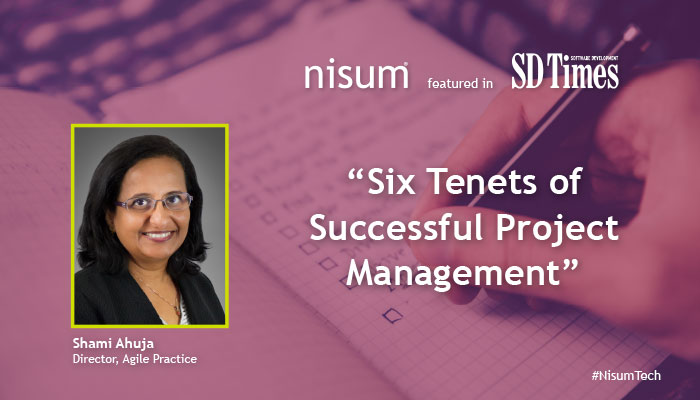"Right now, we are at the point where many organizations have mastered 'doing' Agile and are moving towards the goal of 'being Agile,'" said Shami Ahuja, Nisum Director of Business Consulting and Agile Development in the CIO Review. Read the full article below or on CIO Review here.

From Doing to Being: The State of Agile in 2017
Within the software development community, it's commonly acknowledged that taking an Agile approach is not simply a methodology, but rather, a movement that promotes evolutionary development, adaptive planning, and speedy changes. As the movement continues to evolve, the definition of "Agile" is changing within the IT department, while other areas of the enterprise are taking note and applying an Agile approach to new areas of business.
A traditional waterfall approach to workflow in a sequential method that most organizations and departments follow by default. A plan is made, that plan is followed, a product is released, the result is evaluated, and the process repeats. Agile, on the other hand, takes a more flexible, team-based approach. Large projects are broken down into smaller pieces that are completed on a weekly basis, and the completion of each iterative piece undergoes a micro version of the process described above, generally resulting in more responsive and flexible teams.
Right now, we are at the point where many organizations have mastered “doing” Agile and are moving towards the goal of “being” agile. However, the evolution from practicing Agile development to becoming an Agile based and driven organization is not a change that takes place overnight; it is a philosophical mind shift that must permeate throughout an entire organization. This is no easy task, but can be accomplished through implementing certain practices across teams and emphasizing autonomy, simplicity and measurement.
Autonomy
Gartner recently reported that becoming Agile is now a top priority for many application development organizations, but that the process of becoming Agile may not involve one single methodology. Much like children have to learn how lo crawl before they walk, and walk before they run, organizations have to start with "doing” Agile and then continue their journey to “being” Agile.
When the highest levels of an organization have mastered how they are doing agile on a company-wide level, more productivity can be achieved by giving individual teams more autonomy to perform Agile as it works best for them. More often than not, no two teams practice Agile in exactly the same way, and part of truly becoming an Agile organization is allowing project teams to function in the ways that work best for them. Creating a self-organized team is the first step to being Agile.
Simplicity
On a more tactical level, within individual teams, leaders should look to create simple, project agnostic practices to streamline productivity. This can translate to a number of different processes, such as no meetings between 11-3 every day, or delivery of the product only on the fourth Monday of every month, so that people understand goals and can work towards them on a consistent, reliable basis, which ultimately leads lo better estimates of work.
This also works to alleviate the challenges that can often arise when ad hoc opportunities get thrown at developers and different stakeholders in a project have different priorities.
Measurement
As leaders look for best practices in managing their teams, it's imperative to take a holistic approach towards metrics and make good use of them to effectively scale teams and projects.
Metrics in general are a good way of ensuring transparency at all levels of an organization, but sometimes, people get lost in numbers and forget the spirit of Agile, which is continuous improvement. Management by micro-measurements leads to micromanagement. The focus is shifted to make numbers look better and better, and graphs more perfect on a daily basis. As organizations start maturing their Agile processes, it becomes important to consider both tangible and non-tangible metrics. Metrics like team morale/happiness is equally important as velocity of the team and should be fed back into the team to improve continuously. It becomes important lo shift the focus of metrics at a macro-level and take a holistic view.
As CIOs and application leaders continue to recognize the organizational benefits of Agile (transparency, iterative development, workflow improvement and cost reduction, to name a few) it's crucial to move beyond simply doing agile, to being an agile organization. In finding and adopting the Agile methods best suited for an organization, autonomy, simplicity and measurement will be key is easing the transition.



